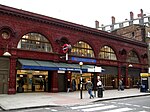The Great Northern, Piccadilly and Brompton Railway (GNP&BR), also known as the Piccadilly tube, was a railway company established in 1902 that constructed a deep-level underground "tube" railway in London. The GNP&BR was formed through a merger of two older companies, the Brompton and Piccadilly Circus Railway (B&PCR) and the Great Northern and Strand Railway (GN&SR). It also incorporated part of a tube route planned by a third company, the Metropolitan District Railway (MDR). The combined company was a subsidiary of the Underground Electric Railways Company of London Limited (UERL). The B&PCR and the GN&SR were established in 1896 and 1898 respectively but construction of both railways was delayed while funding was sought. In 1902, the UERL, which already controlled the MDR, took control of both companies and quickly raised the funds, mainly from foreign investors. A number of different routes were planned, but most were rejected by Parliament. When it opened in 1906, the GNP&BR's line served 22 stations and ran for 14.17 kilometres (8.80 mi) between its western terminus at Hammersmith and its northern terminus at Finsbury Park. A short 720 metres (2,362 ft) branch connected Holborn to the Strand. Most of the route was in a pair of tunnels, but 1.1 kilometres (0.68 mi) at the western end was constructed above ground. Within the first year of opening it became apparent to the management and investors that the estimated passenger numbers for the GNP&BR and the other UERL lines were over-optimistic. Despite improved integration and cooperation with the other tube railways, the GNP&BR struggled financially. In 1933 it and the rest of the UERL were taken into public ownership. Today, the GNP&BR's tunnels and stations form the core central section of the London Underground's Piccadilly line.
Recently selected: Ofotbanen - Rail transport in Vatican City - Asker Line
